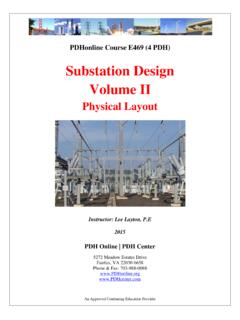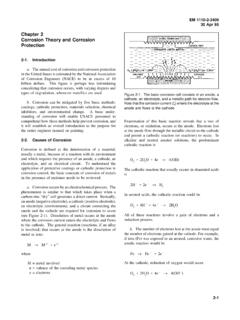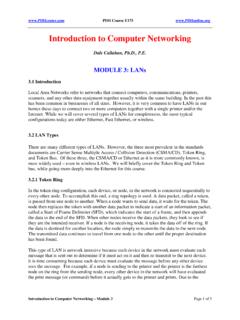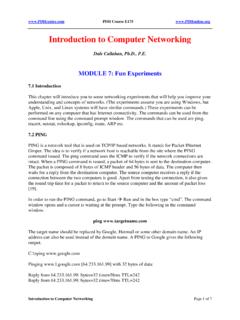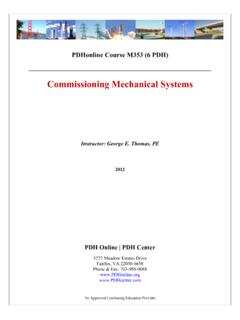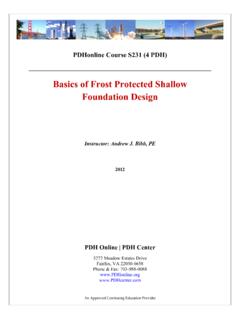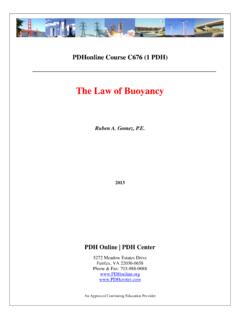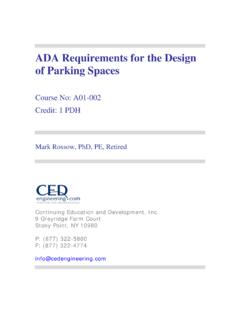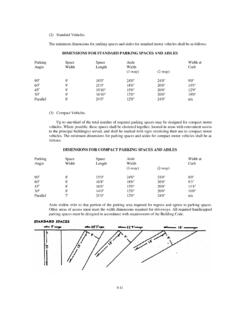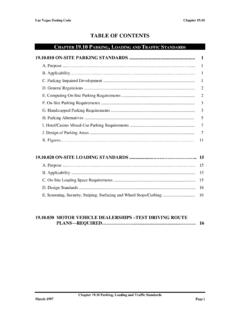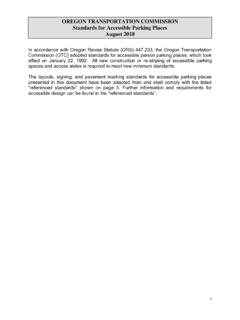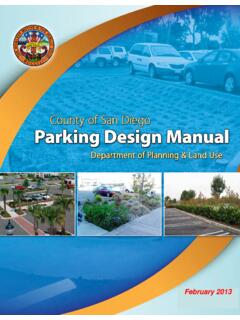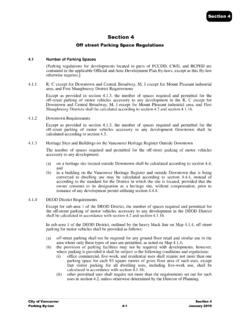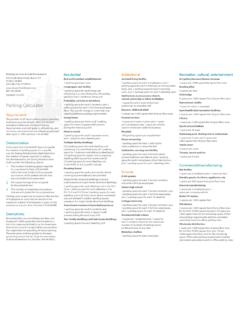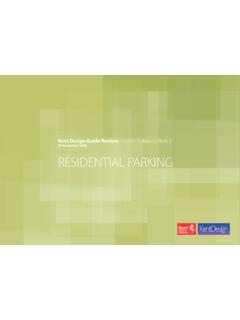Transcription of Complete Parking Lot Design - PDHonline.com
1 PDHonline Course C620 (6 PDH). Complete Parking Lot Design Jerry D. Morrow, PE. 2013. PDH Online | PDH Center 5272 Meadow Estates Drive Fairfax, VA 22030-6658. Phone & Fax: 703-988-0088. An Approved Continuing Education Provider PDHonline Course C620 Complete Parking Lot Design PAVEMENT, DRAINAGE, LIGHTING, STRIPING, SIGNAGE, BARRIERS, LANDSCAPING AND MAINTENANCE. INTRODUCTION. Parking LOT Design . HANDICAPPED ACCESSIBLE Parking . FLEXIBLE PAVEMENT SYSTEM. SIDEWALKS AND RAMPS. SHUTTLE BUS STOPS. SECURITY. DRAINAGE. LIGHTING. STRIPING AND MARKING. Parking BARRIERS. LANDSCAPING. MAINTENANCE AND REPAIRPARKING LOT Design . 2013 Jerry D. Morrow Page 2 of 51. PDHonline Course C620 General Great Parking lots are safe, attractive, drain efficiently when it rains and are screened from residential areas.
2 Striping and signage indicating regular and handicapped Parking spaces, as well as direction of traffic flow, should be clearly marked. Safe pedestrian walkways, including easy access for wheelchairs, need to be separate from the traffic-flow areas. Landscaping that offers shade and visual relief while maintaining good sight lines is beneficial. In areas where it snows, good Parking -lot planning also demands setting aside holding areas where snowplows can pile snow without blocking Parking spaces or the flow of traffic. Parking lot Design involves many considerations. All too often the only consideration for the Design is developing a sufficient Parking area to meet the required number of vehicles based on adjacent occupancy.
3 Local regulations will dictate many of the planning and Design decisions made by the planner or designer. This class presents ideas and methodologies for many concepts that could be inconsistent with these local requirements. Often, these ordinances are a minimum requirement and consideration can be given to other concepts. Good Parking lot will maximize the total number of Parking spaces in the space available with the following considerations: The Parking layout should provide continuous flow of traffic through the lot. There must be safe pedestrian movement from Parking to buildings. The Design should allow for appropriate landscaping of the Parking areas without conflicting with site lighting. Pedestrian and Vehicular Circulation Circulation patterns should be as obvious and simple as possible.
4 All likely pedestrian routes should be considered in the Design phase to eliminate short cuts which will eventually damage landscaped areas. All site facilities and amenities should be accessible to people with disabilities. Circulation systems should be designed to avoid conflicts between vehicular, bicycle, and pedestrian traffic. Pedestrian circulation should take precedence over vehicular circulation. Where pedestrian circulation crosses vehicular routes, a crosswalk with yellow striping in plastic paint, speed bumps, or signage should be provided to emphasize the conflict point and improve its visibility and safety. Circulation routes should focus upon main entries and exits 2013 Jerry D. Morrow Page 3 of 51.
5 PDHonline Course C620 and also identify secondary access points. All elements of the site Design should accommodate access requirements of emergency service vehicles. Access to Parking Areas All off-street Parking spaces should be accessible without backing into or otherwise re-entering a public right-of-way, unless it is physically impossible to provide for such access. When an off- street Parking area does not abut a public street, there should be an access drive not less than 24. feet in width for two-way traffic, connecting the off-street Parking area with a public street. Handicapped Accessible Parking Spaces The location, size, and number of handicapped Parking spaces should conform to the latest building codes, state and federal laws.
6 Handicapped accessible Parking spaces should be located on the shortest accessible route of travel to an accessible facility entrance. Where buildings have multiple accessible entrances with adjacent Parking , the accessible Parking spaces must be dispersed and located closest to the accessible entrances. An accessible route must always be provided from the accessible Parking to the accessible entrance. Ideally, an accessible route would not have curbs or stairs, and be at least three (3). feet wide, with a firm, slip-resistant surface. Accessible Parking spaces should be at least 102 inches wide. Parking access aisles should be part of an accessible route to the building or facility entrance. Two accessible Parking spaces may share a common access aisle.
7 Parked vehicle overhangs should not reduce the clear width of an accessible route. Driveway Entrance Design The location of driveways is based upon many factors, including the location of individual property lines and available street frontage, requirements of internal site Design , number of vehicles expected to use the driveways, and traffic safety. Generally, the farther from an intersection a driveway can be located, the less it will affect the through traffic and the less delay it will cause to vehicles using the driveway. Driveway approaches should be constructed so as not to interfere with pedestrian crosswalks. Driveways should be constructed a minimum of three (3) feet from any obstruction such as a street light or utility pole, fire hydrant, traffic signal controller or telephone junction box.
8 Driveway entrances should be designed to accommodate all vehicle types having occasion to enter the lot, including delivery and service vehicles. 2013 Jerry D. Morrow Page 4 of 51. PDHonline Course C620 Parking Lot Layout Drives that do not allow Parking within the driveway right-of-way are normally 24' for two-way traffic and 12' for one-way traffic. For drives serving thirty (30) or fewer vehicles and where Parking is not provided on either side, the width for two-way drives can be reduced to twenty-two (22) feet. Aisle widths are dependent upon traffic flow (one or two-way), angle of Parking and whether or not Parking is on both sides of the aisle. See Figure 1 for examples. Figure 1. Parking LOT AISLE WIDTHS. 2013 Jerry D.
9 Morrow Page 5 of 51. PDHonlin ne Course C620. 0 DRIVEWA. AY. Dimensions All parkiing spaces, exclusive e of access drivees or aisles, should s consiist of a rectaangular area not less than t eight annd one-half (8 ) feet wide w by eightteen (18) feeet in length except that parallel Parking p stalls should be ten (10) feet by twenty (20) feet. For F Parking dimensions d refer to Figure F 2 and Table 1 beloow: Figure 2. ACCE. EPTIBLE PAARKING. DESIGNS S. 2013 JJerry D. Morrow w Page 6 off 51. PDHonline Course C620 One Way Two Way Angle Dimensions Traffic Traffic Parking Stall Curb Stall Stripe Aisle Sectio Aisle Sectio Angle Widt Lengt Depth Lengt Widt n Widt n h (ft.) h (ft.) (ft.) h (ft.) h (ft.) Width h (ft.) Width A B C D G E F E F.
10 30 17 12 24 45 12 14 24 60 16 24 90 18 18 22 58 24 60. Table 1. Figure 3. PERPENDICULAR (90 ) Parking . SPACES. 2013 Jerry D. Morrow Page 7 of 51. PDHonline Course C620 The following exceptions to the minimum standards apply: Spaces Near Obstructions. When the side of a Parking space adjoins a wall, column, or other obstruction that is taller than feet, the width of the Parking space should be increased by 2 feet on the obstructed side, provided that the increase may be reduced by 3 inches for each 12 inches of unobstructed distance from the edge of a required aisle, measured parallel to the depth of the Parking space . (See Figure 5). Figure 4. 2013 Jerry D. Morrow Page 8 of 51. PDHonline Course C620 Planter Overhangs.
